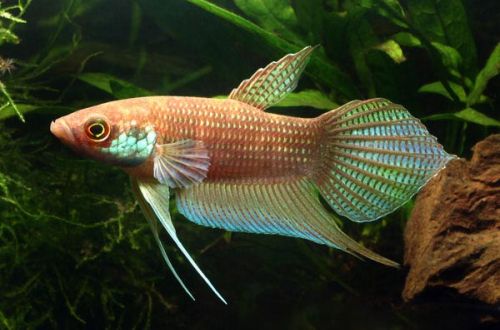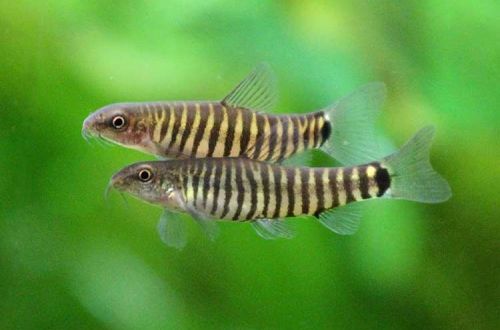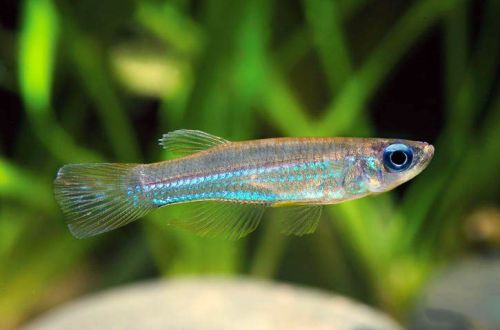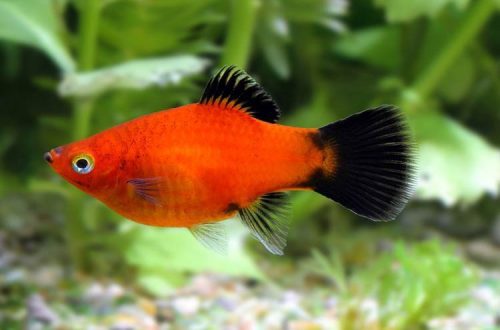
Cockerel mask
The masked cockerel, scientific name Betta raja, belongs to the Osphronemidae family. It belongs to the group of fighting fish, but at the same time it does not differ in warlike behavior, having a peaceful, calm disposition. Unpretentious and easy to keep, but due to the rather faded color, this species is rarely found in amateur aquariums.

Contents
Habitat
It comes from Southeast Asia from the Indonesian island of Sumatra. The natural habitat covers the central provinces of Jambi and Riau. Inhabits small forest rivers and streams, backwaters, peat bogs. A typical biotope is a shallow body of water located in the midst of a tropical forest. Due to the dense canopy of trees, very little light reaches the surface of the water, so even on a bright day, twilight remains under the canopy. The bottom is covered with a thick layer of fallen leaves, twigs and other plant debris. The decomposition of plant organics leads to the release of a large amount of tannins, from which the water acquires a rich dark shade. Aquatic vegetation is provided mainly by shore plants, mosses and ferns.
Brief information:
- The volume of the aquarium – from 80 liters.
- Temperature – 22-27°C
- Value pH — 4.0–7.0
- Water hardness – 0–10 dGH
- Substrate type – any dark
- Lighting – subdued
- Brackish water – no
- Water movement – little or no
- The size of the fish is 6–7 cm.
- Food – any food
- Temperament – peaceful
- Content – alone, in pairs or in a group
Description
Adult fish reach a length of 6-7 cm. Males and females are similar to each other, but males develop elongated fin tips, and there are more turquoise colors in the color. In general, the color is gray, but in certain lighting it may appear reddish.
Food
Undemanding to the diet, the look will accept most popular products intended for aquarium fish. A good addition to dry food (flakes, granules) will be live or frozen brine shrimp, daphnia, bloodworms, fruit flies, mosquito larvae and other small invertebrates.
Maintenance and care, arrangement of the aquarium
The optimal size of the aquarium for two or three Cockerels starts from 70-80 liters. Fish that have been living in an artificial environment for several generations, as a rule, have acquired adaptation to slightly different conditions than those in which their wild relatives live. For example, many breeders and pet stores keep fish in ordinary half-empty tanks, where there is nothing but equipment. Of course, such a design, or rather its absence, is not an ideal choice, so if possible, you should make it look like a natural habitat. The main elements of the decor are a dark sandy substrate, leaf litter, driftwood and shade-loving plants. Leaves are optional but welcome. They not only serve as part of the design, but also affect the composition of the water. Read more in the article “Which tree leaves can be used in an aquarium.”
Successful long-term keeping of the Masked Cockerel depends on maintaining stable water conditions within an acceptable range of temperatures and hydrochemical values. To do this, the aquarium is equipped with the necessary equipment and a number of mandatory maintenance procedures are carried out, in particular: weekly replacement of part of the water with fresh water, timely removal of organic waste (food leftovers, excrement), etc.
The filtration system is usually the main source of water movement, and since the fish prefer stagnant wetlands, you will need to choose a filter that does not cause excessive flow. In small tanks with few inhabitants, a simple airlift filter with a sponge will do just fine.
Behavior and Compatibility
Males tend to be competitive in the struggle for the attention of females, but unlike other Betta fish, it rarely comes to skirmishes. Nevertheless, in a limited space, it is desirable to maintain a community of one male and several females, avoiding the introduction of a potential rival. Peaceful in relation to other species, compatible with non-aggressive fish of comparable size. Overly active neighbors can push the Cockerel to the periphery of the aquarium.
Breeding / breeding
A species aquarium is considered a favorable environment for breeding, where there are no representatives of other species that can negatively affect the process of spawning and gestation of fry. With the onset of the breeding season, the dominant male, if there are several of them, proceeds to courtship. Spawning is accompanied by a kind of “embrace”, during which the fish seem to wrap themselves around each other. The fertilized eggs end up in the male’s mouth and stay there for the entire incubation period, which takes 9–16 days. This unusual way of protecting offspring has developed evolutionarily and provides the species with a high safety of offspring. The fry that appear may be near their parents, cases of eating are rare.
Fish diseases
The cause of most diseases is unsuitable conditions of detention. A stable habitat will be the key to successful keeping. In the event of symptoms of the disease, first of all, the quality of the water should be checked and, if deviations are found, measures should be taken to correct the situation. If symptoms persist or even worsen, medical treatment will be required. Read more about symptoms and treatments in the Aquarium Fish Diseases section.





